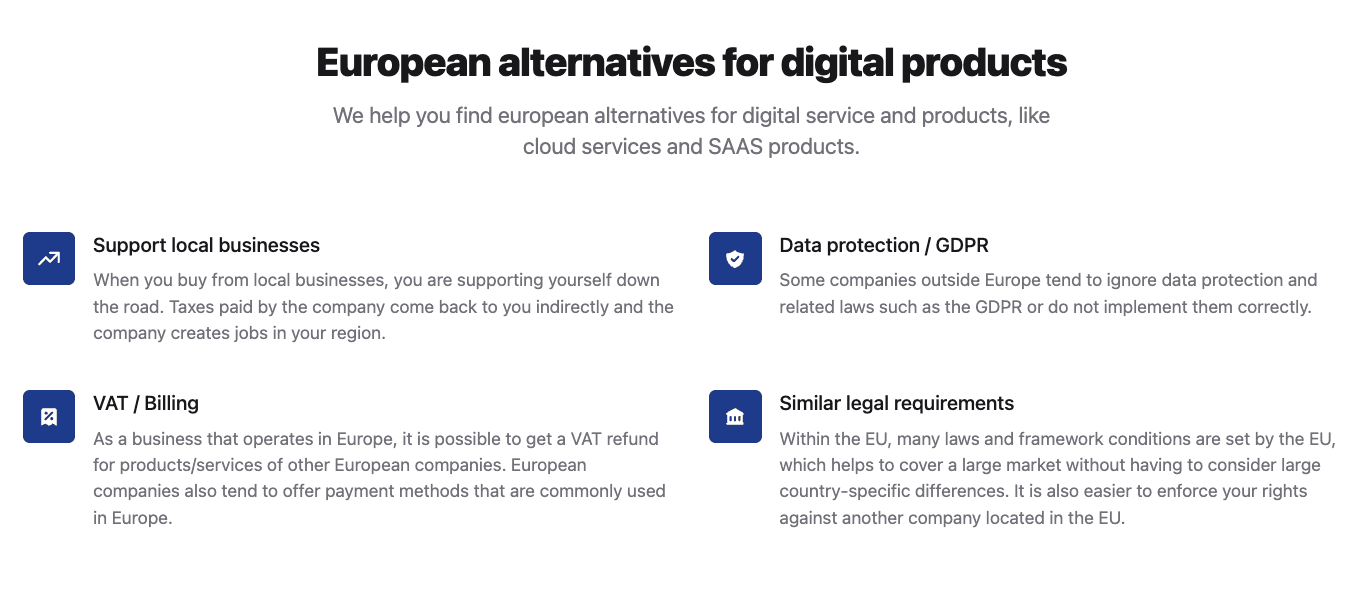Constantin Graf, founder of the platform European Alternatives comes from Vienna and is a freelance web developer. As a side project, he launched the European Alternatives platform in 2021 to end a tedious search for European alternatives in the digital realm. In our conversation, Constantin gives us insights into the creation and development of his platform.
What is the purpose of European Alternatives?
Graf: European Alternatives collects European alternatives to digital services, cloud and SaaS products. These are clearly presented in categories. There are categories for server hosting, email providers, web analytics, enterprise chats and much more. For each European alternative there is a short description, information about which country it comes from and additional labels such as "open source" or "sustainable". The products within a category are ranked according to how good we think the European alternative is.
What prompted you to found the European Alternatives platform?

Graf: Since the NSA affair, I've always looked before I used a new tool privately to see if there was something comparable from Europe. After the GDPR and the problem with the transfer agreement became more serious, I also looked at whether it would make sense to use a European tool for new projects, wherever possible.
In doing so, I noticed how tedious this research is. Lists of alternatives were often not available or only in comments on Reddit. And even if you then found a product, it is often difficult to quickly find out where the company behind it actually comes from. Often this information can only be found somewhere small in the middle of the T&Cs.
At some point I thought that several people must feel the same way and started European Alternatives.
How is the platform financed in the meantime? Is it true that you started the project on a voluntary basis?
Graf: Yes, that's right. Until recently, I cross-financed European Alternatives with my freelance work. Since about a month we have a sponsor who supports the platform financially. I plan to go more in that direction in the future.
In addition, some listed companies offer affiliate marketing, with which, if someone clicks on a link and buys something, we earn a little bit. However, the products with affiliate link will not be preferred. For example, it does not change the position in the category.
In your opinion, what are the strengths and weaknesses of European tools compared to US tools?
Graf: European tools sometimes have to invest quite a lot of time and money to deal with stricter European laws. One example of this is data protection, for example. This usually benefits customers because the stricter laws are often in their favor.
U.S. tools often have much more venture capital to expand. So they grow very quickly and offer many features. I think European companies therefore focus more on one thing than developing all-in-one products.
Features, UX, pricing, environmental protection, green hosting and open source are the most important criteria when evaluating European providers!
Constantin CountFounder of European Alternatives
What are the requirements for admission to European Alternatives?
Graf: To be listed on European Alternatives, the company's registered office must be in an EU country or a country that is located in Europe and has a strong relationship with the EU. This currently includes EEA, EFTA, and DCFTA countries.
Additionally, we list open source products that are easy to host yourself.
The rules have been continuously expanded or concretized, such as the relative new open source rule.

What are the 3 most important criteria when evaluating European suppliers?
Graf: The first step is to look at all the features a product offers and how well they are actually implemented. This also includes whether value is placed on UX and how professionally the company works in general. It seems to me that web design and UX are often neglected in European alternatives.
Then I look at the pricing. Is the price justified and which target group does the pricing appeal to?
Third, I look at how the product comes to be that way. Is it powered by renewable energy and what does the company behind it generally do to protect the environment? If it's not a hosting provider myself, then I look as best I can to see where the product is hosted. Is it run by a European provider of the server, etc.?
For some of these criteria, there are separate labels that make it easier to find products that are open source or hosted green.
These things may not seem central at first glance, but the tools that are compared on European Alternatives are usually in use for quite a long time because it does take effort to migrate. Therefore, in my opinion, such issues should also be considered when making a decision.
What advice do you have for founders who want to establish a new IT solution on the European market?
Graf: I believe that a European company can have a great advantage in the European market if it is marketed well. But the European "stamp" alone is not enough in the long run. Companies should make sure they are innovative and keep up with technical developments.
Sproof is already proudly represented on the European Alternatives Platform under the category European electronic signature software as well as in the Alternatives section under European alternatives to DocuSign .
We at sproof of course use some European alternatives internally, such as Plausible, Scaleway and sendinblue. Tools, which can also be found on Constantin's platform.
More blog entries
What is the eIDAS Regulation? Basics & advantages at a glanceThe digital signature is making its way into Austria's law firms.Digital sustainability in the hotel and catering industry: HOGAST saves measurable resources with sproof signKyocera & sproof. A little digitization fairy tale. The greatest in hotel and catering: Hogast signs with sproof sign.


